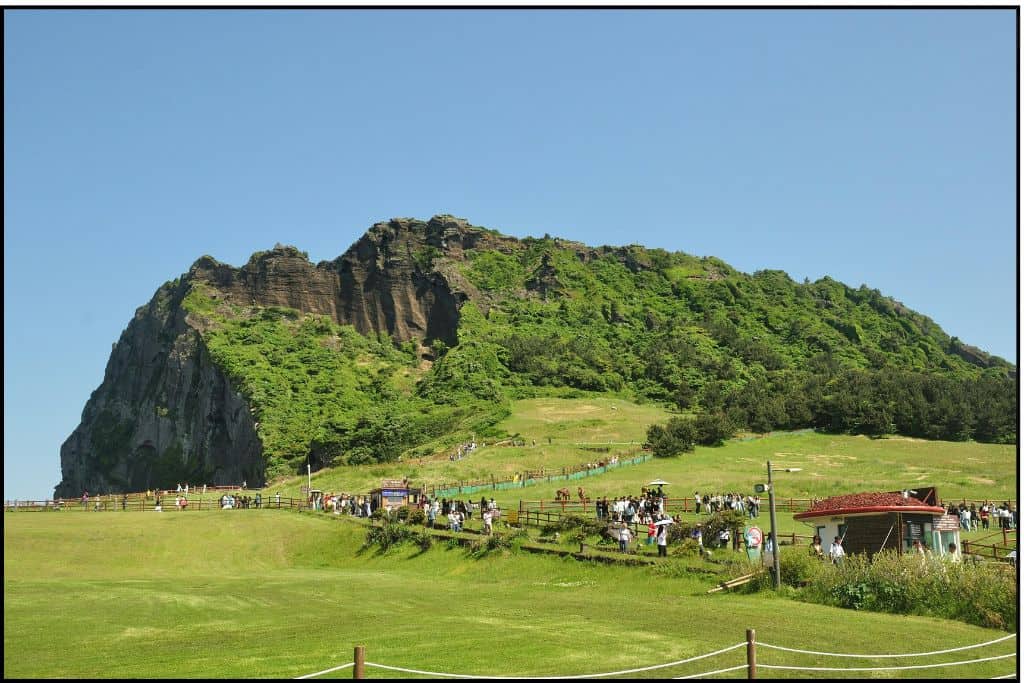
If you ask around, most people will tell you that you really need to rent a car when you visit Jeju. And they’re not wrong… for some travelers.
I took a guided tour on my first trip and still haven’t decided whether I’ll drive next time I visit.
So I dug into the big question: can you explore Jeju without a car? The answer? You can. But it takes planning and flexibility.
Expect longer travel times, a few transfers (sometimes two or three), and the possibility of getting caught in the rain.
If you’re relying solely on public transit, consider staying in Jeju City, as that’s where most routes connect and transfer times are easier to manage.

Traveling around Jeju without a car isn’t for everyone, but if you’re up for a bit of problem-solving, it can be an affordable and rewarding way to see the island.
In this Jeju bus travel guide, we’ll walk you through the different types of buses on the island, from sightseeing loops to airport routes, to help you decide whether taking public transit exclusively is the right move for your trip.
✨This post is a follow-up to my guide on how to visit Jeju without a car. If you’re just starting to plan your trip, especially where to stay, I recommend starting there first. This post dives specifically into using the bus system once you’re on the island.
TL;DR: Should You Take the Bus in Jeju?
Yes, you can get around Jeju by bus, but it takes planning, flexibility, and a bit of patience.
Expect longer ride times, transfers, and route limitations in rural areas. If you’re staying near the airport or in downtown Seogwipo, the system becomes much more manageable.
Types of Buses on Jeju Island
There are several routes in Jeju’s bus system, each intended for a distinct purpose, ranging from quick local hops to cross-island trips and connections.
Let’s break down the main categories, starting with the ones you’ll use the most: regular city buses.
Regular City Buses (Green, Blue, Red)
Jeju’s city bus system might seem overwhelming at first glance, but it’s surprisingly manageable once you understand how the buses are categorized:
- 🟢 Green buses run on local, short, specific routes
- 🔵 Blue buses are intercity buses and serve as mainline routes, covering longer distances with more stops — perfect for getting between cities or some attractions.
- 🔴 Red buses are express routes that cover long distances and make limited stops at key destinations and some tourist attractions, mainly between Jeju City and Seogwipo.
See the full list of the different buses and their stops here.
Airport Limousine Buses (600, 800, 800-1)
If you’re heading to Seogwipo or Jungmun straight from the airport, the Airport Limousine Buses are easily the most convenient option, especially if you’ve got luggage or want to avoid the hassle of multiple transfers.
These large, air-conditioned buses include designated luggage compartments and follow hotel-heavy routes.
You’ll find them at Gate 5 outside Jeju Airport’s arrivals area.
- Bus 600 stops at major hotels in the Jungmun Tourist Complex and ends at Seogwipo KAL Hotel. Travel time: ~50 minutes to Jungmun, ~80 minutes to the final stop.
- Bus 800 bypasses Jungmun and heads straight to the Seogwipo Bus Terminal, taking about 70 minutes.
- Bus 800-1 finishes at the Jungang Rotary in central Seogwipo. The trip takes approximately 80 minutes.
You’ll need to buy a ticket at the airport, as these buses have assigned seating. Boarding without a ticket might not be allowed.
Look for the ticket machine near Gate 5, or ask an airport staff member if you’re unsure.
While these aren’t part of the regular city bus system, they do accept T-money cards if you board mid-route.
Fares are a bit higher than standard buses, but the comfort and simplicity, especially when you’ve just landed, make it a smart choice.
Click HERE for more info on the Airport bus schedules
Tourist Shuttle Buses (Routes 810 & 820)
Jeju’s Tourist Shuttle Buses, Routes 810 and 820, are a fantastic way to explore the island without a rental car.
These loop-style sightseeing buses are tailored for travelers, connecting top attractions along the east (810) and west (820) coasts.
Each route has two versions (810-1/810-2 and 820-1/820-2) that run in opposite directions, making it easy to hop on and off depending on your itinerary.
But these buses aren’t just about convenience. They also give you access to parts of the island that most day tours skip.
For example, the quirky Greem Café (yes, the famous 2D café on the top floor of the Aerospace Museum) and the serene Snoopy Garden are both along these routes.
If you’re planning a Jeju itinerary without a car, this might be the most underrated option out there.
Just keep in mind that you probably won’t hit every stop in a single day. I recommend narrowing it down to your top five and focusing on those.
Although these are sightseeing buses, they’re still part of Jeju’s public transportation system.
To catch one, you’ll need to take a regular city bus to reach the shuttle’s starting point. If you’re staying in Jeju City, expect about an hour of travel time. As always, I recommend mapping your route ahead of time using Naver Map.
👉 Quick tip: When using Naver, search for “Daecheon Transfer Bus Stop” instead of “Daecheon Transit Center,” and “Donggwang Yukgeori” instead of “Donggwang Transit Center.” That’s how I found the correct stops without confusion.
Once you’re there, you can board with a T-money card. If you plan to ride more than once, grab the ₩3,000 unlimited ride pass, available at Daecheon Transit Center (for Route 810) and Donggwang Transit Center (for Route 820).
There might be a chance to buy it on the bus (since there’s a guide onboard), but the official guidance is to pick it up at the transit centers.
Buses typically run from 8:30 AM to 5:30 PM, and some routes only operate once per hour, so be sure to time your transfers carefully.
This is hands-down one of the best ways to explore Jeju by bus, especially if you want more flexibility than a day tour, but still want to cover a lot of ground.
There’s also an official PDF map you can look at that shows each route, attraction stops, and local bus connections. It has valuable information in it. You might even save it to your phone!
Jeju City Tour Bus (Hop-On, Hop-Off)
If you’re staying in Jeju City and want a stress-free way to explore the island without transfers or complicated planning, this hop-on, hop-off Jeju bus tour is a solid pick.
It’s completely separate from regular city buses and the tourist shuttles.
It’s a great option for travelers exploring Jeju without a car, especially short-term visitors, cruise ship travelers, or anyone who just wants to enjoy the ride.
There are two main courses:
- Downtown Course – Covers Jeju City’s cultural and historical spots
- Coastal Course – Travels along the scenic coastline
Key stops include Dongmun Market, Jeju Folklore Museum, Sarabong Park, and even Jeju Airport (Stop #3).
Just note: this bus is designed for sightseeing, not as a flexible form of transportation.
Operation Details:
- ❌ Closed on Mondays
- 🕒 Runs daily from 9:00 AM to 7:30 PM (last departure at 5:00 PM)
- ⏱️ Each loop takes about 2 hours
- ⏳ Buses arrive every hour
Ticket Info: You can buy tickets when boarding (cash, card, or T-money card) and receive a wristband or purchase in advance. Just show your receipt when you hop on to receive your physical ticket.
Ticket Prices: Current Fare Info (2025)
- Adults: ₩12,000
- Children & Teens: ₩8,000
- Persons with Disabilities/National Merit: ₩6,000
- Preschool Children: Free
You can view the official route map and timetable here (English available).
📍Important Note: This tour only operates within Jeju City. It doesn’t travel to Seogwipo, the east coast, or other major island attractions. If you’re sticking to Jeju City, it’s a relaxing and easy way to check off the main sights.
Seogwipo Electric City Tour Bus (Route 880)
If you’re staying in Seogwipo and want to explore Jeju without a car, the Electric City Tour Bus might just be your best-kept secret.
This eco-friendly loop (Bus 880) isn’t flashy like a double-decker.
It quietly connects some of the most scenic spots along Jeju’s southern coast. No transfers or complicated route planning required.
The route starts and ends at the Seogwipo Hyangto 5-Day Market, so it’s easy to pair your ride with a snack break or a bit of souvenir shopping. (Just note: the market is only open on days ending in 4 and 9.)
🌱 As part of Jeju’s public transportation push toward carbon-free travel, this all-electric bus is both environmentally conscious and traveler-friendly.
🕐 It’s a great pick if you’re short on time, want a simple sightseeing loop, or are already based in the Seogwipo area.
Curious about the route? View the official schedule and stops for the Seogwipo Electric City Tour Bus (Bus 880) here and see if it lines up with your travel plans.

Must-Know Jeju Bus Routes for Tourists
These are Jeju city bus routes that happen to be super convenient for sightseeing. It’s perfect if you’re not joining a tour but still want to get around Jeju without a car.
🚌 Bus 201 – East Coast
Connects Jeju Bus Terminal, Seongsan Ilchulbong, and Seogwipo Bus Terminal, giving you access to major eastern sights with fewer stops than typical local buses.
🕒 Runs every 15–30 minutes
🚌 Bus 202 – West Coast
Runs from Jeju Bus Terminal to Gosan and ends at Seogwipo Bus Terminal, following the western edge of the island.
Great for reaching western beaches and spots like Hyeopjae or Hallim Park.
🕒 Runs every 15–25 minutes
Need more details? Click here for more info on bus 201 & 202 routes, stops, and schedules.
🚌 Bus 701 – Coastal East
Another east coast route, with more frequent local stops.
Popular for Seongsan Ilchulbong and the surrounding areas.
🕒 Slightly slower than Bus 201 due to more stops
🚌 Bus 702 – Coastal West
Follows the west coast from Jeju City through Hyeopjae, Hallim, and down toward Seogwipo.
🕒 Like 701, expect a slower ride with more stops
Want more details? Click here for more info on bus 701 & 702 routes, stops, and schedule.
Bus 240 – Hallasan Hikes
Great if you’re planning to hike Eorimok Trail on Hallasan. This one heads inland.
🕒 Schedules vary — check KakaoMap
Need more details? Click here for more info on bus 240 routes, stops, and schedules.
🗺️ Reminder: These are city buses, not tourist-only services. You’ll still want to use Naver or KakaoMap to find the best stop and check the latest schedule.

Travel Tips for Using Buses in Jeju
Once you’ve wrapped your head around all the different bus types in Jeju, here’s how to actually use them without losing your mind (or your day to transfers).
These tips are based on a combination of in-depth research and how other travelers navigate Jeju’s public transportation system, essential reading if you’re exploring Jeju without a car.
Stay Near the Bus Hub
If you’re staying in Jeju City, try to book a hotel near the airport. It’s one of the main transfer hubs and gives you the easiest access to the island’s broader bus network.
In Seogwipo, look for accommodations in or near the old downtown area, especially along the Bus 880 route, which loops past many major southern sights without requiring transfers.
Plan Ahead with a Navigation App
Before you book accommodations, open the KakaoMap or Naver Navigation app and test routes to a few must-see destinations.
Look at the number of transfers, which types of buses are involved (express, local, etc.), and total travel time. Once you find a manageable route, save it in the app so you’re not scrambling on the day of.
Want next-level info? Try the Jeju Bus – Jejudo Busro app. It shows live arrival times, bus capacity, and even stop-by-stop progress, super useful for tight connections or complicated trips.
Use a T-Money Card — It’s Required
Jeju buses no longer accept cash so you’ll need a T-Money card to ride.
But there’s good news: you get two free transfers within 40 minutes if you tap in and out correctly. Just don’t forget to reload it when needed.
Book a Tour if It’s Too Much
If the idea of navigating multiple bus transfers feels daunting, consider joining a guided tour to experience Jeju’s highlights without the logistical headaches.
Whether you’re interested in UNESCO sites, scenic landscapes, or cultural experiences, these tours offer convenient and enriching options.

Recommended Jeju Tours for a Hassle-Free Adventure
If you’re short on time or just don’t want to mess with long transfers and bus schedules, a guided tour is the easiest way to see Jeju’s top sights.
This one gives you two solid options: East Coast or West Coast. You’ll choose your route under select itinerary when you book. Same link, same page. Just pick your favorite and go.
👉 Check tour dates, select itinerary, and book here

Jeju Bus FAQs
The Airport Limousine Buses (600, 800, 800-1) are your best bet if you’re staying in Seogwipo or Jungmun. These buses run directly from Jeju Airport, include luggage compartments, and are much more convenient than regular city buses, which often don’t allow large suitcases on board.
Yes — you can use a T-money card on most buses in Jeju, including regular city buses, the Tourist Shuttle Buses (810/820), and the Airport Limousine Buses. You’ll also get up to two free transfers within 40 minutes if you stay within the system and remember to tap your card when boarding and getting off.
Most of the time, yes — Jeju buses follow their schedules, especially in urban areas. But delays can happen, particularly in rural parts of the island or during bad weather. If you’re transferring between routes or planning a packed sightseeing day, it’s smart to build in a little buffer time just in case.
The most reliable apps are Naver Map and KakaoMap. You can also try the Jeju Bus – Jejudo Busro app for live bus locations, seat availability, and stop-by-stop tracking.
Yes! I follow the official Jeju Tourism Instagram too — @visitjeju.en, and it’s genuinely helpful. They regularly post updates in English, including event announcements, seasonal travel tips, and even weather alerts. It’s one of the easiest ways for international travelers to get up-to-date Jeju info without digging through Korean-language websites.
Final Thoughts: So… Can You Really Take the Bus Around Jeju?
I think so. If you’re up for a bit of planning, longer ride times, and a few transfers.
Whether it’s the best option depends on your travel style and how flexible you’re willing to be.
Apps like Naver Map make routing easier, and staying near a major hub really helps.
And if some sights feel too far out? A guided day tour can save time and cut the stress.
No matter how you get around, Jeju is worth the effort, waterfalls, sea views, and Instagram-worthy cafés included.
Planning a trip to South Korea?
Don’t miss my other travel guides to help you plan the ultimate adventure — from city strolls in Seoul to beach escapes in Busan.
Start with my Seoul Itinerary and Busan Itinerary to map out your journey!
Need KTX tickets? Book your KTX train tickets early for an easy connection to the ferry port.

